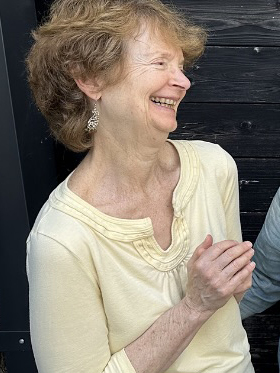The 1950s and 60s



Mid-century childhoods, with pieces by Judy Lee Green, Marianne Patty and Rosanne Singer.
7 minutes
TRANSCRIPT
Many of us in the Passager community grew up in the 1950s and 60s. This episode features three pieces about that period.
Judy Lee Green said her family’s very first brand new car was a 1955 Plymouth Savoy. Here are some excerpts from her memoir “The Tampa Turquoise Flash.”
New cars sold like hotcakes in 1955. Dealers could not keep them on showroom floors. Totally redesigned from previous years when colors were limited and differences few, they looked mouth-watering good to consumers who were living the good life in a robust economy following WWII and the Korean Conflict. Television antennas and window air conditioners could be seen in modest homes. Automatic washing machines replaced wringer washers. Four-party telephone lines appeared even in rural areas. And in front of houses that were built during WWII without driveways, because airplanes rather than automobiles were produced for the war effort, new cars set like trophies in the street.
It was during this time on a warm autumn day in 1955 that my daddy purchased his very first brand-new car. We drove to downtown Chattanooga one Saturday morning in a black 1949 Plymouth and drove home a few hours later in a Tampa Turquoise, 1955 Plymouth Savoy. The new car cost my parents eighteen hundred dollars, a lot of money to a young carpenter with a grade school education whose only financial security was a strong back . . .
The salesman talked to Daddy about the futuristic look of the new Plymouth, the economy of driving all week on a dollar’s worth of gas, the amazing horsepower, quick takeoffs, and the convenience of having a defroster on the heater . . .
Our new Plymouth was a six-cylinder, four-door Sedan with standard transmission. My daddy insisted that an automatic transmission, widely available in new cars, would be nothing but trouble and was probably a passing fad . . .
The 1955 Plymouth was the largest of the low-priced three American automobiles, Ford, Chevrolet, and Plymouth, and size was an important consideration for a family with five kids. Completely redesigned and reengineered for the first time since WWII, it was advertised as Metal in Motion. Plymouth had gone from stale and staid to sophisticated and powerful in one short year.
Our 1955 Tampa Turquoise Plymouth had a matching cloth interior and a turquoise steering wheel, a metal flight deck instrument panel, wrap-around windshield, front and back vent windows, cathedral-styled front fenders, chrome bumpers, and recessed taillights. Reflecting the attitude and adventurous spirit of the American people, it had the slight suggestion of fins which would soon dominate American car design. There were no seat belts or air bags in the 1950s. The only accessories on our brand new car were the heater and defroster. It had no radio.
Excerpts from Judy Lee Green’s memoir “The Tampa Turquoise Flash” from Passager Issue 49.
Marianne Patty said that when a classmate from grade school asked her years later about her memories of growing up, she remembered that when they announced over the loud speaker that Stalin had died the class applauded. Here’s her poem “When Stalin Died.”
in an overheated bedroom
in a dacha surrounded
by swirling snow
Lenin’s portrait
mysteriously incinerated
Berea and Malenkov
Bulganin and Khrushchev
tossed back tumblers of vodka
their eyes on the prize
and each other
watched wives wept
behind closed doors
in dark-walled rooms
for husbands who had vanished
Polish skeletons languished
in communal graves
Brubeck played
“How High the Moon”
at the Blue Note in Chicago
and Sister Saint Ambrose’s
third grade class applauded.
“When Stalin Died,” Marianne Patty, from Passager Issue 55. Josef Stalin died from a stroke March 5, 1953. He was 74.
We’ll end the podcast with a poem based in the late 60s. Rosanne Singer said, “I thought about a child’s drawing of a person and how that corresponded to my adolescent view of growing up , head to toe. Each body part had its own emotional content.” That led her to write “The Shape of This Girl.”
Parabola hair like a helmet,
part straight down the middle
as befits a German daughter.
There is left, there is right
There is right, there is wrong
There is black, there is white.
Full moon face and the endless cycle:
Speak up but not with those words
why are you silent? Speak up
but not with those words. Silence.
The line from the neck
to the waist:
on one side courage, on the other safety.
Be strong, show some spine
but not like the Queens teenager
who dated a black man in 1969.
Hide yourself
in this triangle of a skirt,
like a six-year-old’s stick drawing.
Stand up straight, don’t come
to the dinner table wearing lip gloss
or eye shadow.
Cylinder legs won’t go far
but won’t get you lost.
They are solid containers, restrainers
of restless leg syndrome and
any other restlessness you might feel.
“The Shape of This Girl,” Rosanne Singer, Passager Issue 61. She said, “Originally, I wanted to write this as a shape poem, but it didn’t work out that way.” Years after Passager published this poem, by the way, Rosanne became Passager’s assistant editor.
To subscribe to, or learn more about Passager and its commitment to writers over 50, go to passagerbooks.com. You can download Burning Bright from Spotify, Apple and Google Podcasts, Audible, and a host of other podcast apps.
For Kendra, Mary, Christine, Rosanne, and the rest of the Passager staff, I’m Jon Shorr.



